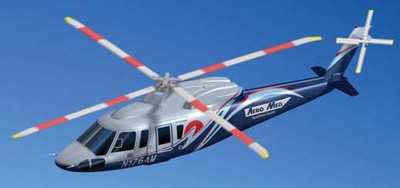In the report, the NTSB notes witness statements the
helicopter's tail rotor appeared to contact a radio tower just
before the helicopter crashed onto the roof of Spectrum Health
Hospital, and the description of events seems to bear out those
reports...
NTSB Identification: CHI08FA141
14 CFR Part 91: General Aviation
Accident occurred Thursday, May 29, 2008 in Grand Rapids, MI
Aircraft: Sikorsky S-76A, registration: N176SH
Injuries: 2 Serious.
This is preliminary information, subject to change, and may
contain errors. Any errors in this report will be corrected when
the final report has been completed.
On May 29, about 1101 eastern daylight time, a Sikorsky S-76A
helicopter, N176SH, operated by Aero Med Spectrum Health, was
destroyed by post impact fire after the tail rotor struck a tower
while departing from the heliport (MI97) on top of the Spectrum
Health Hospital, Grand Rapids, Michigan. The airline transport
(ATP) rated pilot and the ATP rated Federal Aviation Administration
(FAA) inspector received serious injuries. The 14 Code of Federal
Regulations Part 91 flight departed the Gerald R. Ford
International Airport (GRR), Grand Rapids, Michigan, at 1041.
Visual meteorological conditions prevailed at the time of the
accident and a company flight plan was filed.
The pilot reported the flight was a FAA Part 135 check, which
included an annual Sikorsky proficiency check and a 6-month
helicopter instrument proficiency check. They departed GRR and flew
the Global Positioning System (GPS) approach to the hospital
heliport and landed on the pad. Before takeoff, the pilots
discussed the construction cranes that were operating on the north
side of the hospital and their effect on the approach and departure
routes to the pad. The pilot reported that he lifted the helicopter
straight up during the takeoff. The torque was about 94 percent and
"everything was nominal." The helicopter was about 40 feet in the
air when the pilot heard a "pop" and the helicopter started to yaw
to the right and the helicopter started to vibrate. He
instinctively added left pedal to counteract the right yaw, and it
seemed that he had some tail rotor authority. Then the rate of the
right yaw increased rapidly. He attempted to land back on the
helicopter pad by using the cyclic and lowering the collective, but
the main rotor blades impacted the 27-foot high brick structure
located east of the helicopter pad, and the helicopter fell
straight down impacting the hospital roof.
The FAA inspector, who was sitting in the left seat, exited the
helicopter by screwing the pilot's pedals all the way aft and
"shimmying" out the pilot's chin bubble on his back. He helped the
pilot get out of the helicopter through the chin bubble, and they
got behind a heating duct on the roof until the fire fighters
arrived. A fire had started during the initial impact and soon
after the pilots exited the helicopter, it was consumed by
fire.
A hospital nurse reported that she heard the helicopter and went
to the window to watch it takeoff. She saw the helicopter as it
lifted off the pad and as it flew backwards toward the brick
hospital structure and the radio towers on top of the structure.
She saw the helicopter's tail rotor hit a tower.

A witness observed the accident from a 7th floor window across
the street from the helicopter pad. He reported that the
helicopter's tail rotor clipped the radio tower about mid-span and
the tail rotor immediately disintegrated.
A hospital security video camera, which was located near the top
of the brick structure and overlooked the helicopter landing pads,
recorded a portion of the accident flight. It showed the helicopter
as it came in for landing from the south and landed on about a
340-degree heading on the north landing spot. The helicopter stayed
on the deck for about 3 minutes before it departed. The video
showed the helicopter as it lifted off the north landing spot and
it flew backwards toward the brick structure while the nose of the
helicopter remained pointing to the northwest. It showed the
helicopter as it went out of view of the video recorder as it
continued to climb. Since it was a sunny day, the shadow of the
helicopter and the towers on top of the brick structure were
visible on the helicopter pad below. The shadow of the helicopter's
tail rotor appeared to strike an object on one of the towers, and
the tail rotor immediately shattered and the helicopter went into a
right yaw. The helicopter came back into the view of the video
recorder as the main rotor blades began to impact the brick
structure. The video recording stopped and did not record the
helicopter hitting the hospital roof.
A camera that was mounted one of the towers was removed for
inspection. The camera body and its support frame exhibited impact
marks. Carbon fibers were found lodged in a crevice of the camera
body. The support structure that supported the camera exhibited
impact marks.
 ANN's Daily Aero-Linx (04.16.24)
ANN's Daily Aero-Linx (04.16.24) Aero-News: Quote of the Day (04.16.24)
Aero-News: Quote of the Day (04.16.24) Airborne 04.10.24: SnF24!, A50 Heritage Reveal, HeliCycle!, Montaer MC-01
Airborne 04.10.24: SnF24!, A50 Heritage Reveal, HeliCycle!, Montaer MC-01 Airborne 04.12.24: SnF24!, G100UL Is Here, Holy Micro, Plane Tags
Airborne 04.12.24: SnF24!, G100UL Is Here, Holy Micro, Plane Tags Airborne-Flight Training 04.17.24: Feds Need Controllers, Spirit Delay, Redbird
Airborne-Flight Training 04.17.24: Feds Need Controllers, Spirit Delay, Redbird




